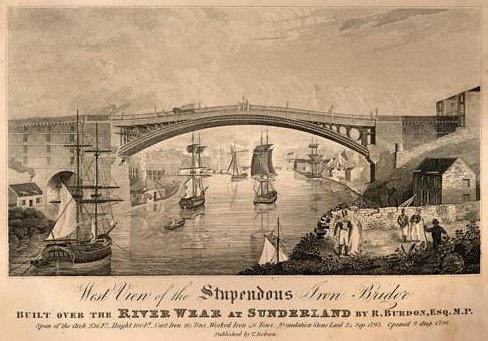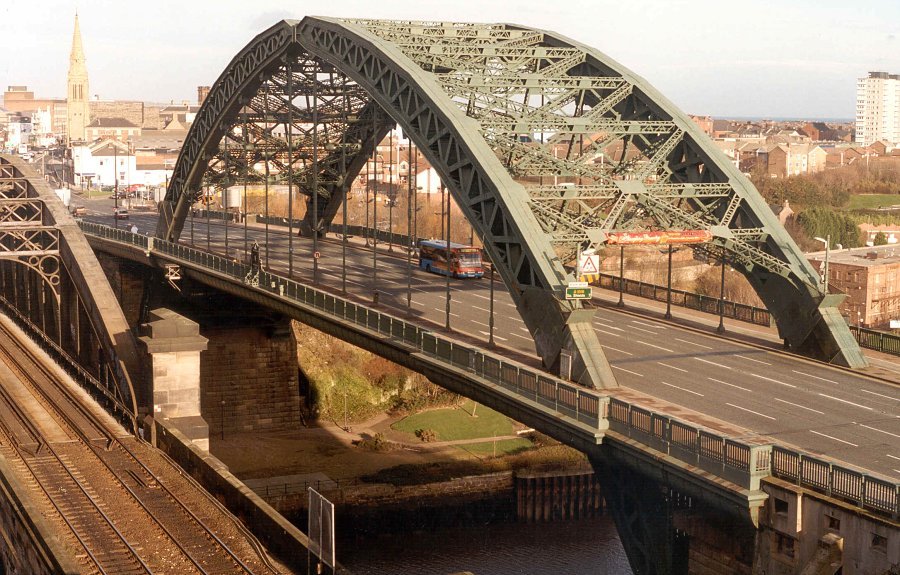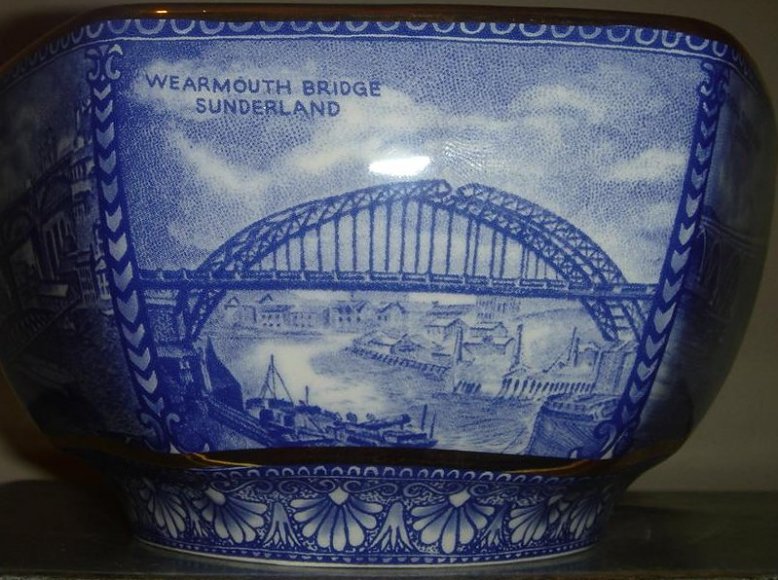THOMAS M. M. HEMY (1852-1937) - PAGE 40
THE WEARMOUTH RAILWAY BRIDGE
& THE WEAR
BRIDGE (1882)
(& RELATED ETCHING)
|
Thomas M. M. Hemy
datapages
01,
02
&
03 are now on site. Plus all
of the other image pages, accessible though the index on page
05. If you want to make a comment, a site guestbook is here. Test. To search for specific text on this page:- Enter your search term & 'Submit'. To repeatedly search the page, press 'ALT S' again & again as many times as may be required. But beware, once it reaches the bottom of the page, it starts all over again at the top. It is always a pleasure to access my e-mail in the morning and
find that
someone, somewhere in the world, has been in touch & has provided new data about Thomas M. Hemy
&
his works. So I sincerely thank Brian Wharmby of Leicestershire, U.K., for providing the
fine work that is presented on this page. And also the work on page
41, that
used to also be on this page. Both are sepia etchings of the River Wear in
Sunderland, & both are 50 cm x 35 cm in size. THE WEARMOUTH RAILWAY BRIDGE AND THE WEAR BRIDGE
It may very well be that the image at left is the original work which became the above etching. It was at auction at Tennants Auctioneers in Jul. 2006.
I now learn, thanks to Mr. Andy Dennis of Sunderland, U.K., that the work sold
at the Tennant's auction for £1,700, rather higher than the pre-sale estimates. Andy advises also that
the purchaser was not the Sunderland Museum. And that in fact the work
was bought by a most interested private collector. Thank you for your input, Andy! SOME WORDS ABOUT THE TWO WEARMOUTH BRIDGES It is appropriate, I believe, to provide information on this page about the two Wearmouth bridges depicted
in Thomas Hemy's works, which truly are unique depictions of a bygone age in the
history of Sunderland. However the webmaster has never visited
Sunderland, & errors can easily creep into text when one writes words without first hand knowledge. Hopefully any errors
in my text will, in due course,
be identified & brought to the webmaster's attention by Sunderland residents perhaps or by others whose knowledge will permit.
And next is a fine photograph indeed, of Engine No. 67689 crossing the 1879 railway bridge - An Allan Edwards image. I saw this image on the 'old photos' section of Bob Exton's 'Circle City Communities' website and particularly here. The full size complete image is available at that link at the click of the mouse. I do not show all of it here so that you can view it without scrolling. We thank both Allan Edwards for the use of his image and Bob Exton for obtaining Allan's kind permission. From the 1960s, I suspect.
THE ROAD BRIDGE
A visitor might appreciate a little knowledge of Sunderland and of its past to appreciate the history of the road bridge. First, one
should understand that Sunderland is close to the North Sea, & that the River Wear
(pronounced Wee-er & tidal to some distance above Sunderland), astride which the city sits, flows through
some very high banks indeed. For generations, one could & did cross the river
by ferry but with some considerable inconvenience.
One would cross by a chain ferry, or by a
flat bottomed rowing boat called a 'coble' or maybe 'cobble'. But the gorge was so wide that no bridge in stone, then the way
that bridges were constructed, could span
the gorge which is 250 feet or 75 metres wide. A further difficulty was that the bridge needed to
be constructed in a single span, so there would be no impediment to tall masted ships passing underneath
it. Sunderland's main business at the
time was the export of coal by sea & access to the coal loading docks by
sea-going vessels was quite essential.
The bridge was tested by
marching 1,000 militiamen across it on Jun. 18, 1796! I bet they were glad when
it didn't fall down, because it would have been a long, long fall to the water
below! There might have been a better way to have tested the bridge!
And another fine image of the 1796 bridge thanks again to 'Wearsideonline' here. Who have a 4 page gallery of Sunderland images on their site. And seem to generally promote the Tyne and Wear area.
The bridge opened with great fanfare on Aug. 9, 1796, the opening being presided over by Prince William of Gloucester & attended by some 80,000 people. It was, when it opened, the largest single span bridge in the world. A toll bridge for traffic & pedestrians, the pedestrian toll being abolished in 1846 & the traffic toll only in 1885. And here is that 1796 bridge again, as it was depicted in 'Illustrated London News' in 1842, viewed from the east, as reported low on this page on this most ambitious of sites, run perhaps by 'J. Weedy' who has 3,000 past issues of ILN & proposes over 20 years or so to show them (and more) on his (or her) site. An amazing and worthy purpose indeed for which he (or she) invites support. That first link shows descriptive words under the bridge image which reports of a person 'who met his doom by leaping from the highest point of Sunderland Bridge'. I am sure that he was not the first to end his life in that way & certainly was not the last.
In these pages, the webmaster is happy to present related data from any source providing it relates to the theme. So next I show an image of the 1796 bridge as it was illustrated on a piece of pottery! A most valuable piece of pottery it would seem. The jug was sold via e-Bay in Sep. 2006 for GBP 280 or approximately U.S. $ 527.49. It had a little damage, it would seem, & surely would have achieved an even higher price had it been of perfect quality. The jug is stated to date from c. 1840, created by the J. Phillips & Co, Sunderland Pottery. This is the 3rd face of the jug depicting the Coat of Arms of 'The Grand Union of Oddfellows'. It would seem that this is not the sole depiction of the bridge on pottery. See below for the 1929 bridge in blue pottery.
I must soon re-organise these pages, because this page with its data and imagery about the
Sunderland bridges is becoming
much too large for comfort. But until such a re-organisation is accomplished here is a splendid image indeed -
entitled 'Sunderland' - of the River Wear bridge in 1832, said to originate
from 'Meyer's Universum'. Viewed from the west. The print, available for purchase in Oct. 2006, is 4 1/4 x 6
1/2 inches in size on a page 7 x 10 1/2 inches in size. The image I present originates with 'martin2001',
of Virginia, U.S.A., a friend of the site if I may so describe him, whose fine
prints have featured in many of my site pages. Why so? Because the images he
chooses to present of his sale items are of a consistently fine quality.
The listing has some related text which
however seems not in fact to relate to this fine image. 'Martin2001', I thank you again.
And next another quite similar print that originates, I understand in Finden's 'Ports, Harbours & Watering Places of Great
Britain', published in 1842. The print is entitled 'SUNDERLAND' & the following words are under the bottom
of the print:
'(THE BRIDGE FROM THE WESTWARD)'
&
'London. Published 1836 by Charles Tilt, 86 Fleet Street.'
It shows the 1796 River Wear bridge in a panoramic view from the west. Drawn by G. Balmer
& engraved
by W. Finden. We thank Gary Defty for this image also. A coloured version of the print is
also available.
Thought to be c. 1845.
That first bridge had a modest 'hump' in the centre, as you can see
in the images above, a hump which proved to be of
some considerable inconvenience to traffic. And with the passage of time major repairs
became necessary. The bridge was substantially repaired in 1805. In 1858 a major reconstruction of the bridge was carried out
to the recommendations of consultant engineer Robert Stephenson & a reconstructed bridge, now
substantially of wrought iron, was opened on Mar. 5, 1859 absent the
'hump' in the centre.
The University of Newcastle believes that the print dates from 1841, was engraved and printed by W & A. K. Johnston of Edinburgh and is of the proposed bridge across the river - see this page. The 1859 bridge is well illustrated indeed in the image that follows - originally published, in 1863, I read, in 'Reid's Handbook to Newcastle Upon Tyne'. The print appears on the most extensive 'Pictures of Gateshead' site, the effort of Mr. Andy Williamson. You can see the image on his site via this page (4th row). And his 'front door' is here. Andy, we sincerely thank you! Images of the 1859 bridge seem to be relatively scarce & this one is a beauty.
And here again is that same 1859 bridge, in a dramatic print that shows the now long gone 'Ironworks' of S. Tyzack & Co. The image comes from the site of the 'University of Newcastle Upon Tyne' and can be seen here ("©SINE Project") along with another image of the 1859 bridge. Indeed, at that page you can 'zoom in' on the print, to view it in greater detail. To the webmaster's eyes the bridge seems to 'dip' a little in the centre, but I am sure that is not, in fact, correct.
Those
Latin words, I now read, were on the city arms or seal of the City of Sunderland.
And here is a postcard image dating from 1931, a Valentines postcard mailed from Sunderland on Jan. 17, 1931. Of the then quite new road bridge. I think my scanning of it might be improved, however.
And here is the 1929 bridge in pottery! Artistic licence I presume, since there would be no position from which such a view would be possible - since the railway bridge IS, like it or not, there. This image is ex e-Bay & the jug featured no less than six U.K. bridges. A 'Rington Tea Merchants' (Rington's of Algernon Road, Newcastle On-Tyne) bowl by Wade Ceramics with a reference to 'Maling". I now read that 'The 'Maling Pottery' of Newcastle upon Tyne, England, was in production from 1762 to 1963, the first Maling pottery being established by William Maling at North Hylton, near Sunderland, in 1762. In 1817, Robert Maling, (3rd generation) moved the facilities to Newcastle where it continued to manufacture through 1963. Maling was associated with Rington from 1928 through 1962. The jug was 6 1/4 or 6 1/2 inches wide by 3 1/2 inches deep. Old? Not particularly I suspect, but collectible most certainly. That e-Bay item sold for GBP 14.50 or approximately U.S. $27.13. Many such bowls have been available, one for the more modest price of GBP 5.19 or approximately U.S. $9.91.
The above is a
distillation of words from many sites. For greater detail than I can provide
here, may I suggest you access other WWW sources including an interesting
two-page pdf document
by the City of Sunderland that is most informative.
One can even buy a 'cross-stitch' pattern of the 1929 bridge, I see, 6th item
down on this page! We sincerely thank Brian Wharmby for images of
the above etching.
And Tennants Auctioneers and Tyne and Wear Museums for what may be the
original work. If YOU
could add more information, do please
contact the webmaster. Thomas M. M. Hemy
datapages
01,
02
&
03 are now on site. Plus all
of the other image pages, accessible though the index on page
05.
|

















